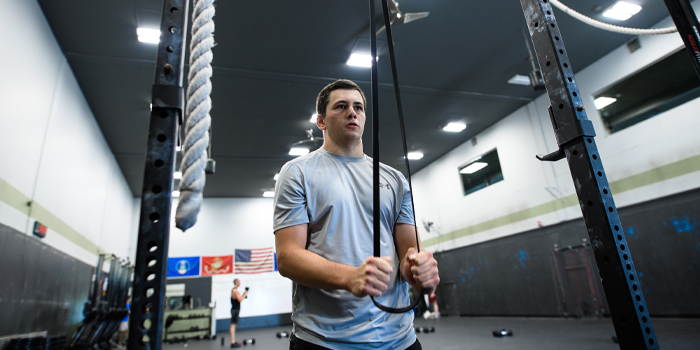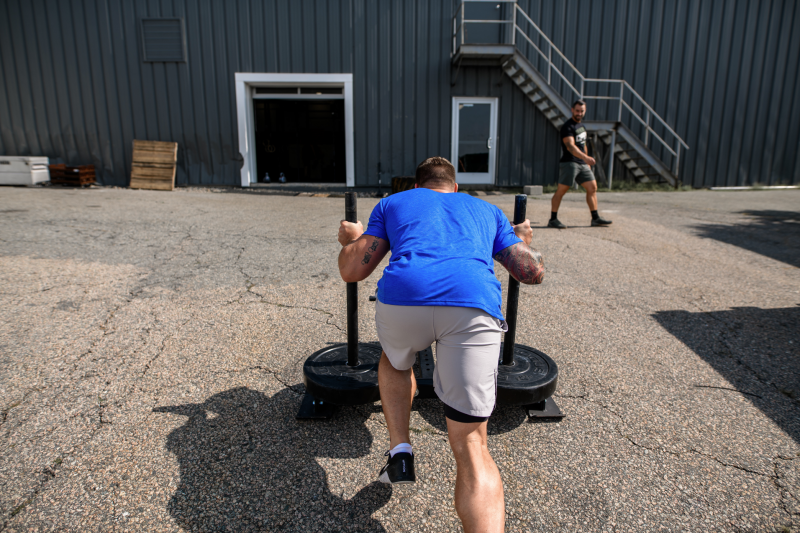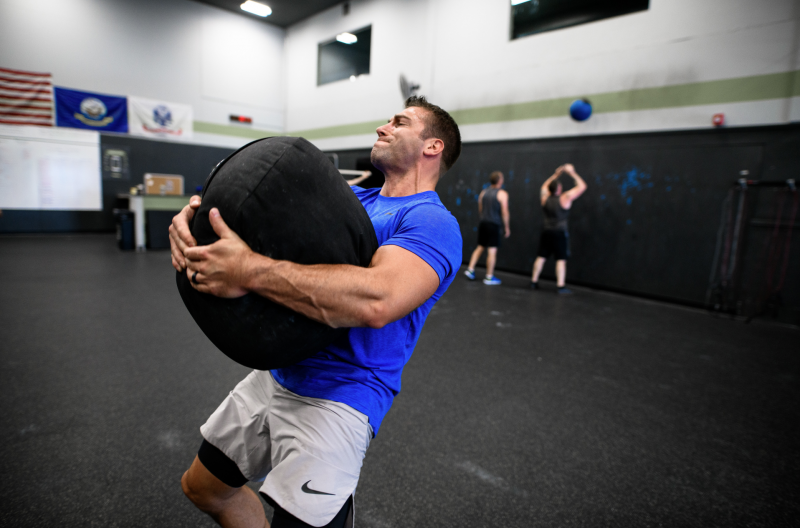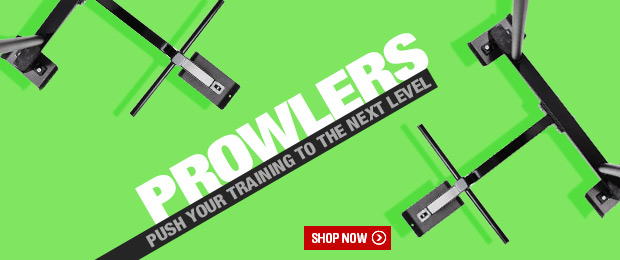
“With training, less is more is always the case." — Dave Tate
Everyone wants to know how to do more or what they can add to supplement their training. Sometimes the best answer is to do less, and for most, simply getting their life on track outside of the gym (diet and sleep) will make the biggest difference.
There is a fine line between enough work and too much work, and by simply browsing Instagram, you can watch box athletes that are absolutely hammering themselves on a daily basis.
RECENT: Use the Air Bike to Train All 3 Energy Systems
Don’t fall into this trap and know that most people are not afforded the same levels of resiliency as others. This is one of the biggest problems in boxes: Everyone wants to mimic the training of the elite —or really, any sport, for that matter.
Look at the comment section of the next brutal (sometimes ridiculous) workout a high-level box athlete is performing. You’ll see 20-plus comments of people tagging friends and stating, “This is what we are doing tomorrow.” Sounds like a well-thought-out and sound plan!
Think about it like this: How many athletes that play college football make it to the professional level? And even if you’re only considering those that are playing Division I-A College Football, the number is miraculously low.
This isn’t meant to discourage anyone; it’s meant to bring the reality of statistics into play so we can start training with reasonable goals and use a reasonable training plan.
If you’re a coach, being realistic with your clients is vital for their long-term success. If you are a coach, I’ll preface this by saying that convincing your clients that more is not more is a monumental task in and of itself.

Additional Work Options
Wanting to do more and being motivated is awesome, but before you consider doing more in the gym ask yourself if you’re doing more outside of the gym (i.e., getting consistent sleep, managing stress, sticking to a clean diet 90 percent of the time).
If you can answer “yes” to all of those questions, then let’s talk about what extra work you can do to improve your fitness that won’t leave you overtrained and invariably miserable.
Sled Work
I’m sure this won’t come as a surprise to many of you. The sled is the MOST valuable piece of equipment many gyms don’t have. Of course, a barbell is pretty valuable, but you simply cannot squat and deadlift every day. The sled, on the other hand, would be tough to overdo. Additionally, the sled can serve a multitude of purposes. Let’s take a closer look.
- Warm-Up: The sled can be used as both a lower body and an upper body warm-up. For instance, starting your lower session with a 200m sled pull or your upper body session with 10 minutes of sled pull rows or triceps extensions is an incredibly effective way to prepare for your training.
- Anaerobic Capacity: This can be trained on max effort training days but should be separated from other high-threshold work by 72 hours. An example of this is 6 sets of 60 yards sled push sprints, resting 2 minutes after each.
- Aerobic Capacity: This can be trained 2-3 times a week. An example of this would be pulling a sled for 30 minutes with a light load at a continuous pace.
- Posterior Chain Development: This can be trained on any heavy lower day (max effort or dynamic effort training). An example of this is 10 sets of 60 yard-heavy sled pull powerwalks with sled straps attached to your weight belt, resting 60 seconds between sets.
- Recovery: This can be done between your harder sessions. An example of this would 30-40 minutes of a sled pull powerwalk at a sustainable pace, alternating between forward, backward, and lateral (this session is comparable to aerobic capacity work but the load should be 5-10% less).
Mixed Sled Work Challenges
These can be a fun way to change things up and will challenge your endurance both locally and globally. Here are a few of our go-tos:
- 800m Sled Pull Farmer Carry: Grab two moderate kettlebells or dumbbells, attach your sled straps to your belt with 25% of your body weight on the sled and walk for a half-mile. Shoot for sub-18 minutes and retest in 8 weeks.
- 800m Sled Pull with Medicine Ball: Grab a medium medicine ball (50 pounds for guys/30 pounds for ladies), attach your sled straps to your belt with 25% of your body weight on the sled, and walk for a half-mile. Shoot for sub-16 minutes and retest in 8 weeks.
- 600m Sled Pull with Kettlebells: Grab two moderate kettlebells or dumbbells, attach your sled straps to your belt with 25% of your body weight on the sled and walk for a quarter-mile. With this challenge, you’ll rotate the positions the kettlebells are in (200m overhead, 200m front rack, and 200m farmer carry). Shoot for sub-15 minutes.
Recovery Work
There is plenty of evidence to confirm that more is not more and that there is a point of diminishing returns.
RELATED: 9 Ways to Upgrade Your Sleep Hygiene Tonight
So, what can we do to make the most out of the training sessions we do have? Global foam rolling, biphasic stretching, and parasympathetic breathing have been game-changers for my clients over the last 12 months, the reason being is we can effectively expedite the recovery process by driving the parasympathetic nervous system (rest and recovery) post-training. For a small investment of six minutes, you can improve your recovery significantly.
An example is:
- 2 minutes of Global Foam Rolling: Prioritize large/dense musculature — lats, quads, hamstrings, pecs, adductors, etc.
- 2 minutes of Biphasic Stretching: Pecs, adductors, hamstrings, etc.
- 2 minutes of Parasympathetic Breathing with Feet Elevated: 15-20 controlled breaths with a 3-second inhale + 1-second hold at the top + 3-second exhale + 1-second hold at the bottom.
Assistance Work
Clearly a lot will fit into the assistance work bubble, but I’m referring specifically to small exercises that help improve lagging muscle groups. If you’ve been training for a decent length of time, you’re probably well aware where you’re weak. Adding additional work with the goal of targeting your limiting factors can serve you quite well. This work is quite simple and something Westside has been doing for years.
The key here is to pick small single-joint bodybuilding exercises to attack your limitations. Keep in mind, this work should not detract from other training sessions and usually enhance your main training days.
At Westside, they usually perform small sessions every 24 hours (i.e., post-max effort lower) and a small 20- to 30-minute hypertrophy session for your lower-body lagging muscle groups.
Skill Work
Taking the time to work on perfecting your Olympic lifts with a light barbell or even your squat and deadlift with a light barbell will improve faulty movement patterns. It’s very easy to avoid this type of work though because it’s easy, but there comes a time that even the most experienced athletes develop bad habits.
To give you an example, recently I realized my deadlift technique had gone to shit after watching a video of my speed pulls. I took the next three weeks to perform speed pulls with loads that I could only perform perfect reps with as well as slowing down the speed of each rep in an effort to be more intentional. Interestingly enough, I was sore in muscle groups that are not usually sore after deadlifting.
LISTEN: Table Talk Podcast #30: How Dave Tate Trained His Clients
Keep in mind, your overall goal is health and longevity, so reinforcing good movement and breaking bad habits is the only way this can happen. Take a step back a few times a month and spend 20 minutes perfecting your squat or pull. And don’t be surprised if you get sore from this work, as you’ll likely fire new muscles that may have not been previously working.

Loaded Carries
I’d love to say that you can’t overdo these, but I’d be hesitant to go that far. In this case, we’d want to include this after your main training session one to two times a week if you’re not already doing so. The benefits include core and grip strength, posture improvement, as well as providing an aerobic effect when intervals are 60 seconds or longer.
Much like with the sled, we are prioritizing work that does not carry high amounts of eccentric contractions, which certainly have the power of taking away from our other training sessions.
Band Work
Strengthening connective tissue will help prevent potential soft tissue injuries. Another benefit of band work is greater storage of kinetic energy via the series elastic component (SEC), which includes muscular components (tendons constitute the majority of the SEC). When the SEC is stretched during an eccentric range of movements, the SEC acts as a spring, which correlates to higher reversible strength (the ability to go from eccentric to concentric contractions), thus improving the explosive strength capability of an athlete.
Additionally, these movements can be done for high amounts of work with no risk of injury and/or delayed onset muscle soreness, which is an added bonus if you’re trying to perform more work and not take away from your main training sessions.
For your clients with lower training ages, these band movements will help improve their mind-muscle connection where it will be easy for them to feel the correct musculature working, as they will not be limited by their lack of experience. These same folks will likely incur hypertrophic adaptations and the ability of the muscle to generate more force thereby increasing their overall strength.
Lastly, you can use band work to prepare for the upcoming training session in your warm-up, so these variations have a multitude of uses and are not just for finishers. Moreover, these movements are incredibly easy to teach and perform, making them a great option for group programming.
Split Your Training Sessions
If you’re able to, breaking up your strength and conditioning work will serve you well and allow you to focus on one training element at a time.
Putting It All Together
Everything listed here will provide a high return on investment. For an additional two hours of total training time a week, you can improve your limiting strength and conditioning factors as well as have a prehabilitative strategy to ensure your longevity.
READ MORE: 10 Things You Can Do to Extend Your Lifting Career
Obviously, this article is for people that are looking for “more” or coaches that have clients that request more work.
Overall, this work should certainly be a part of your normal plan, though. We utilize these measures weekly with great success, so I’m quite confident you and your clients can incur the same results.
Images courtesy of RX Photography











This article I found speaks volume on how demanding this type of exercise is on our systems within our body! Six subjects consisting of powerlifters, rugby players, and bodybuilders with at least 5 years of periodized resistance training performed a maximal push and tow of the motor vehicle over a distance of 400m per trip. It was found that even within a short distance of about 50m, subjects had reached about 44% of VO2max and 90% of maximum heart rate. By the end of each trial subjects had reached about 68% of VO2max, 97% of maximum heart rate.
The intensity of this movement is so demanding, only the bravest will take on such a task for gains!
https://dc.etsu.edu/cgi/viewcontent.cgi?article=3783&context=etd
Nearly every article you reference the sled. However, my gym does not have one. What do you suggest as an alternative?